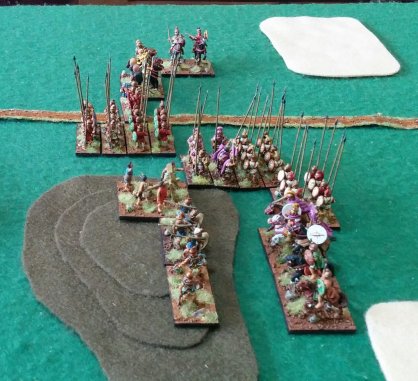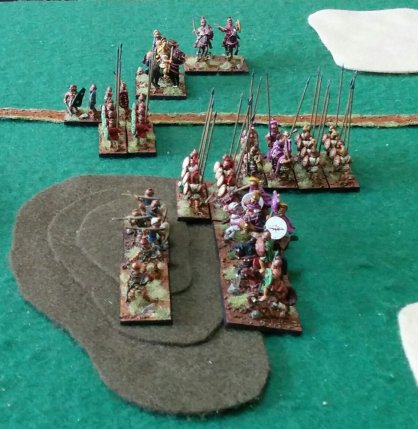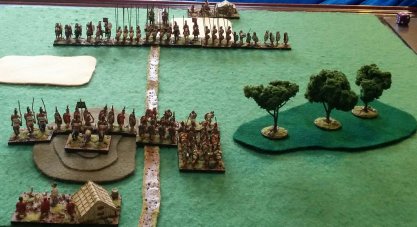Philip V makes trouble (again)!
21 September, 2016
An old friend, Craig, visited today, over from Brisbane. We played a couple of games of DBA. He was over earlier this year and we played a couple of game then too. One was Syracusans against Pyrrhus. Craig was impressed at how the Syracusan bolt shooter performed (it pretty well won the game from memory, even destroying pike in hand-to hand!).
He was keen to try out a pike army, and likes the Late Spartans (II/31e, who had the option of a bolt shooter to his delight). I went with the Later Macedonians, who are significantly better than the 2.2 list (and pike play differently under 3.0 too).
- Spartans v. Later Macedonians
The Philip V, leading the Macedonians, was the defender and went for ploughed fields and two large gentle hills and a road. It then rained (1 PIP first up).

The Macedonians with cavalry and a Galatian warband on the left and Thureophoroi and Thorakitai on the left.
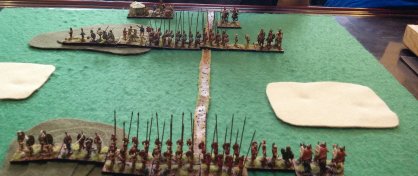
The Spartans, with the artillery next to the Spartan commander and Thureophoroi supporting it. Light Horse are in reserve.
Philip advanced his main body into the gap between the fields. The Spartan stayed stationary and opened up with the bolt shooters. They destroyed the Thorakitai. The next turn Philip was bereft of initiative (1 PIP again). He moved his cavalry up through the muddy field to support the pike. The Spartan bolt shooters fired again and destroyed the Thureophoroi! The Macedonians were not looking in a good space! Fortunately in the next few turns, the leftmost phalanx is only recoiled a few times by the bolt shooters while Philip and his light horse rush to shore up the left wing.
With not enough PIPs to do terribly much, Philip sends in his right wing, and everything goes to plan (there was one?)! The cavalry rout the opposing psiloi, despite being overlapped. The phalanx on the right of the Galatians push back their opposite number, and the Galatians face a phalanx with a double overlap, and destroy it. Suddenly Philip is back in the fight. The Chalkaspides against the Spartan commander are forced to retire; in the circumstances (attacking uphill against the general and overlapped on the left owing to the Leukaspides having been recoiled by the bolt shooters) this was a good result.
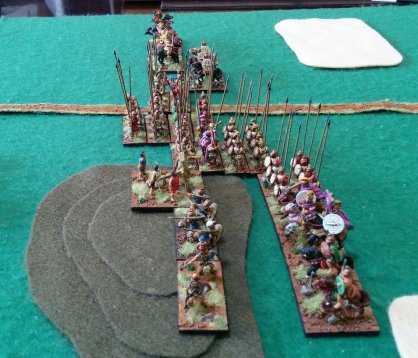
After the initial contact; the psiloi and half a phalanx on the Spartan left wing have vanished. Philip and his light horse have extended their left flank after the loss of their medium foot.
The Spartans made the cavalry pay, destroying it with their light horse and own cavalry. However, the Galatians had their dander up, and they destroyed the rest of the phalanx in front of them. It was now 3-3. The bolt shooter recoils the phalanx opposite them again and the Spartan commander, oblivious to how the battle was developing, forges forward.
Philip is unfazed, or at least his Galatians aren’t. They flank the next phalanx and contribute to its destruction by the Agema. The Spartan commander advances again (were the Chalkaspides skillfully recoiling to take away his overlaps?), and the bolt shooters are demolished by a determined assault by the Leukaspides. Philip and his light horse recoil the foot on the hill opposite them to ensure there were no more upsets in this bloody 6-3 victory.
This was the first outing of the Later Macedonians in a long time. They were not much chop in DBA 2.2. The phalanx could not win in time before the wings folded, but now that pike and blade pursue the dynamics of combat have changed a lot. Also the extra element of cavalry makes for a more interesting army, one I’ll be keen to get out on the board more often.
- Later Macedonians v. Polybian Romans
The success of the Later Macedonians had me wanting to see how they’d perform against Polybian Romans. They were predictably the defender, but had taken an Aitolian ally (II/31j), giving him a 3Kn and an ally block of 4Pk.
The Romans chose to have the wood on their side of the battlefield, hoping to expand out of column in front of it.

The Romans with their cavalry on the left wing and the right wing in column waiting to deploy. The Triarii are deployed to meet the Xystophoroi.
In the opening moves the Romans throw forward a block of velites to delay the Macedonian advance. They are cut to pieces by Macedonian cavalry. The Macedonians reform their line and advance (this was a mistake, as the ally made this cost 4 PIPs, rather than the 2 PIPs available, but we let it pass).
When the Macedonians make contact the Aitolian Xystophoroi destroy the overlapped Triarii they meet. More Triarii plug the gap and resist valiantly, but another block of legionaries is destroyed and the situation is looking hopeless.
Who would have thought Roman cavalry could effect a turnaround? First one element destroys the opposing cavalry, aided by an overlap. The Macedonians falter (low PIPs) and next the Roman commander destroys the isolated Illyrian cavalry in a one on one, while the other cavalry, flushed with their initial success, tackle Philip, aided by velites flanking him, and win! Amazingly out of nowhere the Macedonian cavalry are routed and the disaster in the centre is averted.
Despite the loss the Macedonians acquitted themselves very well with the new list and the new rules. They are now an interesting army. Craig enjoyed both games, both which had surprising reversals of initial success. He’s keen to get his own army for DBA soon.
Zombies
20 September, 2016
As I checked over the paints that I’d not used in over a year, I came across some colours that reminded me that I had a few figures I’d meant to paint. The next thing you know I’m painting a warband of Zombies that I’d based over a year ago. Not content with that I also did some test figures of Troglodytes and Lizardmen that I’d wanted to do. Then I bought some more figures from Splintered Light because they had a sale … Oops!
The Zombies were pretty straightforward. I used drybrushing after I had applied the wash, as I had gone for a pretty drab palate and wanted a bit more contrast than the wash gave.
I’m hoping to start using these warbands for SoBH in something closer to a RPG campaign inasmuch as I envisage that a warband would encounter zombies and other monsters in the course of a campaign. It gives me an excuse to paint quite a number of these warbands. To date I’ve got my Undead largely done (just some ghouls to do) — evil wizards, a vampire, wraiths, ghosts, skeletons and zombies is a bit to get going with. I’ve also got Gnolls and Goblins, along with a few larger humanoids.
The two test figures, the Troglodyte and Lizardman, were straightforward to paint. However, I’m not happy with the colour of their skin. I was hoping a drybrush would work, but I may have to start again. I want something lighter with more variation. I’ll try a heavier drybrush. If it still doesn’t work, I’ll have to redo the base coat. Otherwise, they’ll be a cinch to paint; not too many colours and clear lines for the detail.
The warbands may not get much attention, however, until more urgent DBA projects are finished (or that’s the theory).
Numidians
19 September, 2016
I delved into my lead pile and extracted some figures I bought a good while ago and finally put some paint on them. They had always been an army that shouldn’t have been too much trouble, as they are mostly light horse and psiloi, so few figures, and those not having a lot of variety to their clothes either.
The army was originally intended to be used in a Punic Wars campaign. It’s been finished with a view to being used as an ally to a Marian Roman army. Despite the Corvus Belli figures no longer being made, I am fortunate to be able to field the main options for the army, even with the changes to the list under DBA 3.0.
The heart of the army is its cavalry. I have gone for the Cv general over the LH one. the LH one is probably a better choice for the earlier versions of the army. Otherwise, the army is able to field up to 6 LH and an elephant.

The famous Numidian light horse; you can see two of these were painted some time ago for the Carthaginian army.
The rest of the army is now mostly psiloi; under DBA 2.2 these could have been 3Ax, which would be more useful. I’ve only painted the minimum of four Ps, though I have stacks left, as I’d anticipated basing some of them as 3Ax. What would be good, would be some of the CB Numidian Warriors III (CB408) to use as Imitation Legionaries or Roman-trained regular javelinmen. In their absence I’ll be using Freikorp Imitation Legionaries I’ve already painted.

The not so famous Numidian foot, now all psiloi or a couple of imitation legionaries (on loan from the Seleucids).
I’ve also done a camp using a Baueda hut and figures from Donningtons and Freikorp.
I’m not overwhelmed by the quality of the paintjob; I’m rusty and I was in a hurry to get them done. The wash was a bit rushed, which is something I’ll be more careful about in the future. I should add some stones and reeds to the bases at some stage too. I have started using a wet palate, which has made painting faster and easier.
I did two more elephants, so that I can field a BBDBA Marian Roman army with lots of elephants. I was surprised to realise the elephants were smaller than the Carthaginian one I used for the Numidian army, but it’s less noticable when they’re on the field.
One of them needed a bit of greenstuff to repair his trunk and tail! The moulding was a little poor overall; the feet of the two crew are a bit runty and the mahouts have no goads, which may be moulding or design. The javelins are ridiculously skinny and have broken already once. I’m not sure what their longevity will be.
BBDBA Civil Wars
19 September, 2016
Last Friday Nick and I tried a game of BBDBA. I’d got my Numidians finished and could field a Marian army, albeit with a few of the elements not as I’d want them. Nick put together another Marian army, not with any prior preparation. I was the defender and set up all my commands, followed by Nick. I then rolled 7 total for my PIPs, so made the ploughed rough; not what I’d expected!

The perfidious Caesarians arrayed with their lickspittle lackeys in support; the left command has Spanish auxiliaries, elephants cavalry; the centre command consists of a block of legionaries and a line of them; the right has legionaries and cavalry.
My plan was to win in the centre and hold on the flanks. I gave my high dice to the centre. The Numidian flank was hampered by the ploughed fields.

The glorious defenders of the republic. On the left is the loyal Juba with his elephants, imitation legionaries and Numidians; the centre is Scipio with elephants, legionaries and Spanish auxiliaries; the right has a few legionaries, Spanish auxiliaries and Gallic cavalry, commanded by Labienus.
My initial PIPs were very low, and I was anxious about trying to get my light troops across on my left to intercept the elephants. Nick had his high PIP dice there. I seemed to forget about holding on the flanks, and although I got one of the elephants, that command broke. There was a stalemate across the ploughed field on the right and I actually did win in the centre, where Nick was using some of his legionaries to break my left flank. However, I’d lost patience, and forgotten the plan, and attacked on the right flank. It didn’t go well.
The game took some time and was very close, in that I was close to breaking, but could have won if I’d hadn’t been so rash with the Numidians. In the end Nick broke the Numidians and won the battle. It was a fun game and I learnt a good deal about BBDBA.
We’ll have another game soon; I may have to rethink my commands; the centre could have used a more mobile reserve, but then the left flank would be less effective, possibly. Food for thought!
More on Allan Massie
3 September, 2016
I’ve now finished the Robert Harris trilogy on Cicero. It was very good, but it pales in comparison to Allan Massie’s books. I read his Augustus next, and loved it. Augustus is the narrator, and it is in two halves. The first he narrates to his grandsons Gaius and Lucius. It is optimistic; the second is narrated towards the end of his life and is much more gloomy. Massie paints a picture of somebody who is keen to present his legacy as a service to Rome; he has Augustus’ Res Gestae for this. He presents somebody who is perhaps not so self-aware as he thinks, as comes out when his dynastic plans go awry. Comments from Maecenas and Livia are particularly revealing.
I’d have to read Robert Graves’ I Claudius again (I read it as a teenager), but I think Massie’s portrayal of Livia is probably more believable. She’s a proud Claudian, not shy of reminding Augustus that she deigned to marry down to him!
One of the strengths of Massie’s books is that you very much get the perspective of the narrator, and it is biased. The scene he describes of the forging of the second triumvirate is similar in Augustus to in Mark Antony, which I’m reading now, but the differences are revealing. Augustus justifies himself, while Antony won’t talk of it, and it’s described by his secretary, Critias. I’ve not put the two scenes alongside each other, but the description of discussion of the proscription is modified.
Massie describes Mark Antony very favourably. His biggest failing is his sense of honour (something Ronald Syme suggests too). He would have been best to have crushed Octavian while he had the upper hand, but is described as having given his word, and therefore was not willing to do this. Massie’s description of Antony’s relationship with Marcus Brutus is fascinating; he gives a context for why Antony described Brutus as the noblest Roman at his funeral.
The varied takes on Brutus in the three books I’ve read by Massie so far are a nice illustration of how well he gets into the persona of his narrators. Mark Antony’s sympathy for Brutus contrasts with the antipathy, for different reasons, of Augustus and Decimus Brutus in the two earlier books.
Meanwhile, I have all the figures for the Thapsus BBDBA army. They are all primed and waiting to be painted. The Numidians are close to being done, and the Xyston Gauls and Spanish will mix nicely with the CB ones. It helps that I’m using CB shields. Plans to go to Conquest are also advancing. I had a couple of games of DBA with Nick a couple of weeks ago. We had a Marian Roman civil war, where his Romans with an elephant were undone by my use of Armenian cataphracts (and some good dice). My Seleucids against his Ptolemaics was the reverse, where my PIP dice were cripplingly low; the elephant and the scythed chariot are not forgiving of such dice. It was only that Nick had average combat dice that allowed me to hang around for as long as I did.
